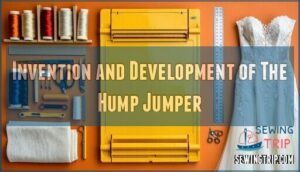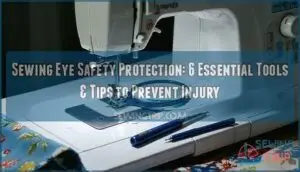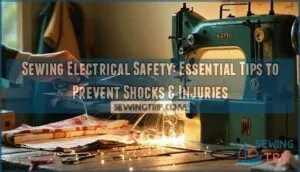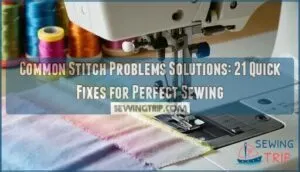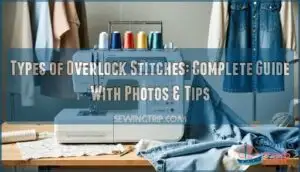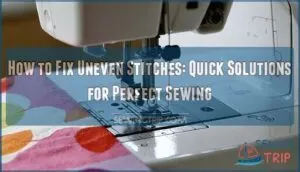This site is supported by our readers. We may earn a commission, at no cost to you, if you purchase through links.
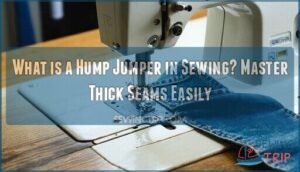 A hump jumper in sewing is a small wedge-shaped tool that helps your sewing machine navigate thick seam intersections smoothly.
A hump jumper in sewing is a small wedge-shaped tool that helps your sewing machine navigate thick seam intersections smoothly.
When you’re stitching denim hems or quilting multiple fabric layers, your presser foot can get stuck on bulky spots, creating uneven stitches or skipped threads.
The hump jumper slides under your presser foot’s back edge, leveling it out so your needle penetrates consistently through thick areas. You’ll also hear it called a height compensation tool or jean-a-ma-jig.
This inexpensive gadget transforms frustrating sewing moments into smooth sailing—no more wrestling with stubborn seams or dealing with broken needles. While you can improvise with folded cardstock, dedicated hump jumpers offer precise angles and durability that make professional-looking results achievable for any home sewer tackling heavyweight projects.
Table Of Contents
Key Takeaways
- You’ll prevent needle breaks and skipped stitches by using a hump jumper to level your presser foot when crossing thick seams and bulky fabric intersections.
- You can tackle heavyweight projects like denim hems and quilts with confidence, as the tool maintains consistent stitch quality across varying fabric thicknesses.
- You don’t need to buy one if you’re on a budget – folded cardboard, fabric strips, or Post-it note stacks work as effective DIY alternatives.
- You’ll position it behind your needle before thick seams and let it slide out automatically as you sew forward, making the technique simple to master.
What is a Hump Jumper in Sewing?
A hump jumper is a specialized sewing tool that levels your presser foot when traversing thick seams and varying fabric layers.
This handy machine accessory prevents skipped stitches and needle breaks by lifting the back of your presser foot, keeping it horizontal over bulky spots.
Whether you’re hemming denim or working with canvas, this sewing aid guarantees smooth passages from thin to thick areas.
Available in 1/16-inch and 8-inch thicknesses, it’s vital for maintaining professional-looking stitches on heavy materials.
Understanding the sewing thick fabrics techniques is vital for achieving superior results with a hump jumper.
Features and Benefits of The Hump Jumper
You’ll discover the hump jumper tool transforms your sewing experience with thick fabrics through intelligent engineering.
This specialized sewing aid features a squared tapered end measuring 3/8" in width, perfectly designed for precise presser foot control.
Available in multiple sizes and colors, it’s compatible with any sewing machine make or model.
The tool’s compact design fits seamlessly under your presser foot, maintaining horizontal positioning when traversing fabric thickness variations.
This prevents needle protection issues and eliminates skipped stitches that plague sewers working with heavy materials.
Your stitch quality remains consistent whether you’re moving from two layers to six layers of denim.
Enhanced sewing efficiency becomes second nature as the hump jumper sewing aid controls runaway gathers and pleats effectively.
The durable construction guarantees long-lasting performance across countless projects.
Whether you’re hemming jeans or tackling quilting intersections, this hump jumper tool delivers professional results every time, making thick seam traversal feel effortless.
By utilizing the right sewing tools, sewers can overcome common challenges and achieve better outcomes.
Solving Sewing Challenges With The Hump Jumper
Mastering thick fabrics becomes a breeze when you know your hump jumper’s full potential. This simple tool tackles common sewing challenges that can derail even experienced sewers.
When you’re hemming jeans, those bulky side seams create uneven surfaces that cause your sewing machine to struggle. Your needle starts skipping stitches or breaking entirely because the presser foot tilts at an awkward angle.
That’s where your hump jumper shines – it levels the playing field by lifting the back of your presser foot. Place it behind your needle before hitting those thick seams. You’ll notice your machine glides smoothly over fabric layers without the usual hiccups.
Thick seams turn your sewing machine into a stubborn mule that refuses to cooperate.
The tool prevents skipped stitches that create weak spots in your finished garment. Quilters face similar battles when crossing multiple seam intersections. Your hump jumper maintains consistent stitch quality across varying fabric layers, preventing those frustrating moments when your thread tension goes haywire.
It’s like having a steady hand guiding your machine through the toughest spots. By understanding the proper hump jumper technique, you can substantially improve your sewing results on thick fabrics.
DIY Alternatives to The Hump Jumper
You don’t need to spend money on expensive sewing aids when your kitchen drawers hold the solution. Smart sewers have been crafting their own thick seam solutions for decades using everyday materials that work just as well as store-bought tools.
Three Simple DIY Alternatives:
- Cardboard Wedges – Cut sturdy pieces from cereal boxes, sizing them to match your fabric thickness
- Fabric Shims – Layer folded fabric strips to create custom heights for different projects
- Post-it Note Stacks – Adjust thickness by adding or removing notes for precise control
Creating homemade tools saves cash while solving the same problems as a JeanAMaJig or commercial hump jumper. Your DIY cardboard wedge lifts the sewing machine presser foot just like the original, preventing skipped stitches when working with thick fabrics.
The key is matching your material’s thickness to your seam’s height – whether you’re hemming jeans or quilting heavy layers, these budget-friendly solutions keep your stitches even and your needles intact. For more advanced techniques, mastering sewing hacks can greatly improve your overall sewing experience.
Invention and Development of The Hump Jumper
Innovation sparked from frustration when Sandy Newman faced challenges sewing thick bridal fabrics in her Beverly, Massachusetts couture shop.
Sometimes the best inventions come from everyday sewing room struggles that demand creative solutions.
The Hump Jumper Origins trace back to 1989, when Newman’s determination to solve fabric thickness problems led to groundbreaking Sewing Innovations.
Her initial Prototype Development involved makeshift solutions using cardboard and rulers before perfecting the design.
This Inventor Biography reveals how a dentist friend helped create early prototypes using a blowtorch and Plexiglas.
Newman’s bright yellow hump jumper became the first dedicated sewing tool specifically engineered for managing varying fabric layers.
The sewing hump jumper’s success earned Newman the nickname "The Hump Jump Lady" from her mold maker.
Her original Hump Jumper design revolutionized how sewists handle thick seams, establishing SN Designs Co as the authentic producer of this essential hump sewing tool that continues helping sewists master challenging fabric transitions today.
Understanding the proper hump jumper technique is vital for achieving professional results in sewing thick fabrics.
Frequently Asked Questions (FAQs)
How does a hump jumper work?
Ninety percent of sewers struggle with thick seams.
You position the hump jumper behind your needle to level the presser foot over bulky fabric layers, preventing skipped stitches and needle breaks.
Can you use a hump jumper on a sewing machine?
Yes, you can definitely use a hump jumper on your sewing machine.
It’s specifically designed for machine sewing, positioning behind the presser foot to level it over thick seams and bulky areas.
How do you use a hump jumper?
Position the hump jumper behind your needle before sewing over thick seams. Lower your presser foot onto it, then start stitching slowly. It’ll slide out automatically as you sew forward.
What is a hump jumper tool?
Like a tiny ramp for fabric mountains, a hump jumper levels your presser foot when crossing thick seams.
You’ll slide it behind the needle to prevent skipped stitches and broken needles on bulky layers.
How do you sew a hump jumper?
You don’t sew a hump jumper – it’s a pre-made tool you buy or make from cardboard.
Simply place it behind your needle before thick seams to level your presser foot.
What are the benefits of using a hump jumper in sewing?
Think of hump jumpers as your sewing superhero – they rescue you from needle breaks, prevent skipped stitches, and create perfectly even seams when moving over thick fabric layers.
What Types of Fabrics and Projects Are Hump Jumpers Most Useful For?
You’ll find hump jumpers most helpful with thick fabrics like denim, canvas, wool, and leather.
They’re essential for hemming jeans, quilting projects, bag making, and sewing over bulky seams where multiple fabric layers create uneven surfaces, making them a crucial tool for working with thick fabrics.
What Size Hump Jumper Should I Purchase?
Don’t overthink thickness selection—your sewing machine’s feed dogs determine what you’ll need.
Purchase both 1/16th and 1/8th inch hump jumpers since different fabrics require different heights for ideal presser foot leveling.
Can I Sew Without a Hump Jumper if I Don’t Have One?
Yes, you can sew without one using folded cardboard as a DIY substitute.
Cut a wedge from sturdy cardboard, position it behind your presser foot, and sew slowly over thick seams, using this method as a DIY substitute.
Are There Any Safety Concerns When Using a Hump Jumper?
Hump jumpers are generally safe, but you’ll want to keep your fingers clear of the needle area and sew slowly over thick spots to maintain control and prevent accidents.
Conclusion
Before learning what’s a hump jumper in sewing, many sewers struggle with thick seams.
After discovering this tool, those same projects become manageable. You’ll find hump jumpers transform challenging fabric layers into smooth stitching experiences.
Whether you’re hemming jeans or quilting multiple layers, this simple wedge eliminates presser foot wobbling and prevents skipped stitches.
Your sewing machine will glide over bulky intersections effortlessly, delivering professional results every time.
- https://napasewandvac.com/the-hump-jumper/
- https://ssndesigns.com/hump-jumper-the-original-one-and-only/
- https://sewsimplebags.com/complete-sewing-glossary-terminology-explained-beginners/
- https://missmaudesewing.co.nz/blogs/miss-maude-musings-1/how-to-sew-thicker-seams
- https://www.youtube.com/watch?v=U91iJMKJ23g


